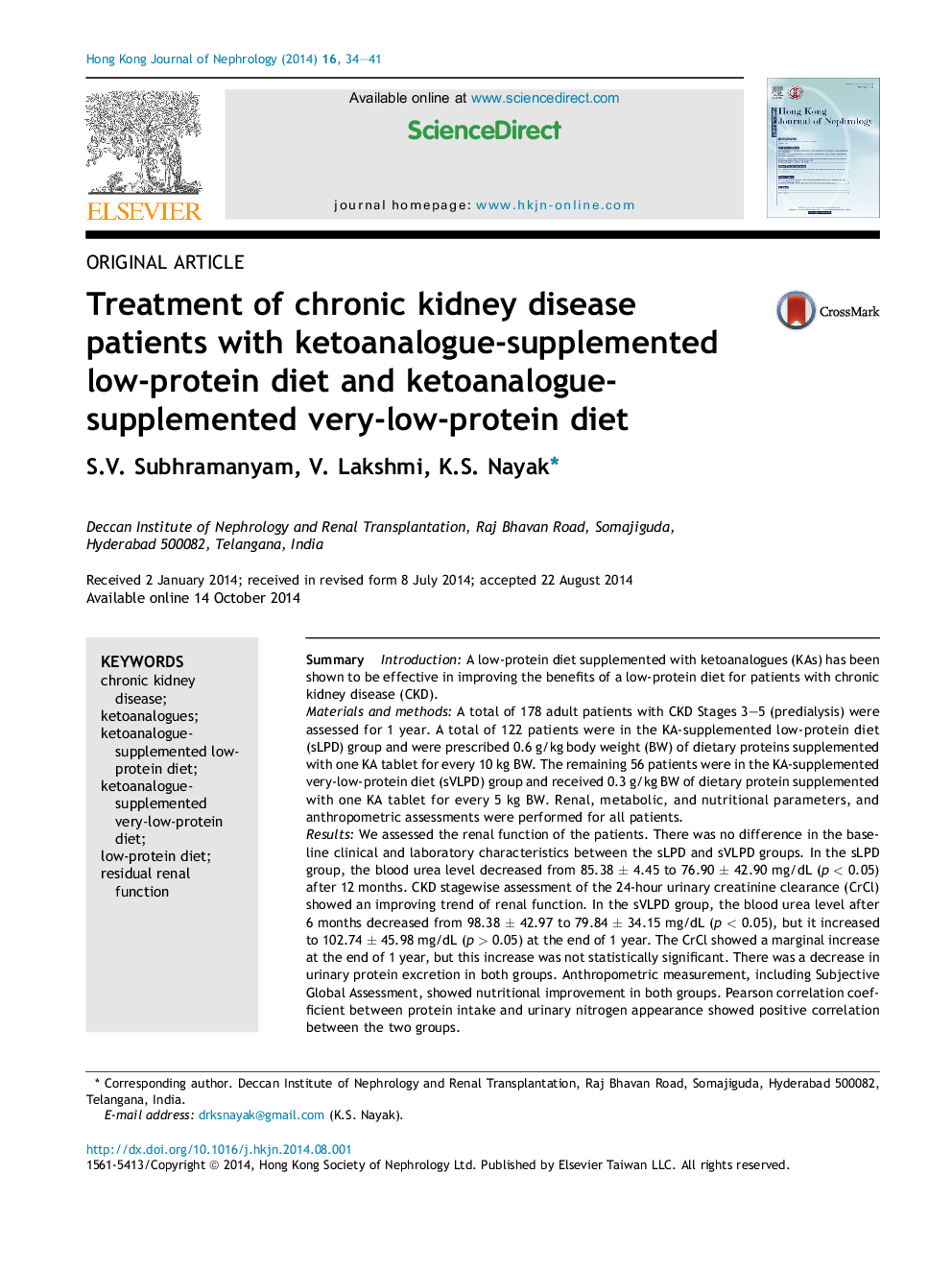| کد مقاله | کد نشریه | سال انتشار | مقاله انگلیسی | نسخه تمام متن |
|---|---|---|---|---|
| 3853973 | 1598543 | 2014 | 8 صفحه PDF | دانلود رایگان |
SummaryIntroductionA low-protein diet supplemented with ketoanalogues (KAs) has been shown to be effective in improving the benefits of a low-protein diet for patients with chronic kidney disease (CKD).Materials and methodsA total of 178 adult patients with CKD Stages 3–5 (predialysis) were assessed for 1 year. A total of 122 patients were in the KA-supplemented low-protein diet (sLPD) group and were prescribed 0.6 g/kg body weight (BW) of dietary proteins supplemented with one KA tablet for every 10 kg BW. The remaining 56 patients were in the KA-supplemented very-low-protein diet (sVLPD) group and received 0.3 g/kg BW of dietary protein supplemented with one KA tablet for every 5 kg BW. Renal, metabolic, and nutritional parameters, and anthropometric assessments were performed for all patients.ResultsWe assessed the renal function of the patients. There was no difference in the baseline clinical and laboratory characteristics between the sLPD and sVLPD groups. In the sLPD group, the blood urea level decreased from 85.38 ± 4.45 to 76.90 ± 42.90 mg/dL (p < 0.05) after 12 months. CKD stagewise assessment of the 24-hour urinary creatinine clearance (CrCl) showed an improving trend of renal function. In the sVLPD group, the blood urea level after 6 months decreased from 98.38 ± 42.97 to 79.84 ± 34.15 mg/dL (p < 0.05), but it increased to 102.74 ± 45.98 mg/dL (p > 0.05) at the end of 1 year. The CrCl showed a marginal increase at the end of 1 year, but this increase was not statistically significant. There was a decrease in urinary protein excretion in both groups. Anthropometric measurement, including Subjective Global Assessment, showed nutritional improvement in both groups. Pearson correlation coefficient between protein intake and urinary nitrogen appearance showed positive correlation between the two groups.ConclusionThe CKD patients on sLPD and sVLPD showed improvement in renal function, metabolic status, and nutrition.方法研究對象為 178 位 3–5 期(透析前)慢性腎病成年患者,其中 122 人接受酮類似物 (KA) 補充之低蛋白飲食 (sLPD)—含每公斤體重 0.6 g 蛋白質及每 10 公斤體重 1 顆 KA 錠;另 56 人接受 KA 補充之極低蛋白飲食 (sVLPD)—含每公斤體重 0.3 g 蛋白質及每 5 公斤體重 1 顆 KA 錠。治療期間的測量項目包括腎功能、代謝、營養學、體格等方面的變化。結果在各項基線臨床及化驗特徵上,sLPD 及 sVLPD 兩組之間無明顯差異。經過 12 個月後,sLPD 組的血中尿素從 85.38 ± 4.45 mg/dl 下降至 76.90 ± 42.90 mg/dl (p < 0.05),24 小時尿液肌酸酐清除 (CCT) 則顯示,在各級腎病患者中,腎功能呈現改善傾向;至於 sVLPD 組,6 個月的血中尿素從 98.38 ± 42.97 mg/dl 下降至 79.84 ± 34.15 mg/dl (p < 0.05),然後於 12 個月增加至 102.74 ± 45.98 mg/dl (p > 0.05),12 個月的 CCT 則呈現增加的傾向。在兩組的病人間,尿液蛋白排泄量均明顯下降,體格方面的測量包括 SGA 均呈現營養狀況的改善。兩組間,以 Pearson's 系數分析可見,蛋白質攝取量與尿液氮出現量呈現明顯的相關性。結論慢性腎病患者在接受 sLPD 及 sVLPD 期間,腎功能、代謝及營養狀況均呈現出穩定化的情形。
Journal: Hong Kong Journal of Nephrology - Volume 16, Issue 2, October 2014, Pages 34–41
